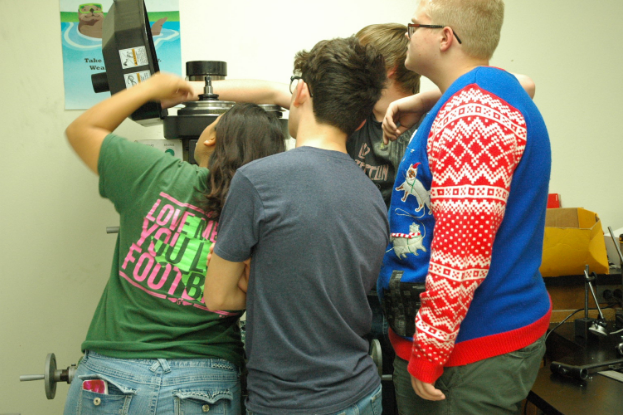Building Your Future
Robotics students to work toward future competitions
From left to right Andrea Garcia, Miguel Chavez, Caleb Welch. Robotics students help incoming freshmen figure out how to use a mill.
December 18, 2017
When people think about robotics, they think all kinds of things. They see a lot of math and building. They see competitions. One thing many people do not think of is something that builds their future.
Robotics helps students learn how to work as a team and how to communicate with different types of people in different types of situations, building skills for the future.
“The purpose of robotics is to help students use their skills to prepare for a real-world setting,” robotics mentor, Allen Mays said. “The purpose is to take all of those different skills and help a student develop them in a way that they can really apply, so when they graduate, they have real-world skills, and they have developed those towards a problem-solving situation so that they can be much more prepared.”
Robotics for most is a foundation for students to better themselves. Robotics is laying the groundwork for students further jobs and their passion.
“I have wanted to be in robotics since I was in eighth grade,” sophomore, Kaylee Mason said. “It always seemed fun and I always liked the idea of being a robot engineer.”
Students relate robotics to a sport. This sport, though, tests your mind.
“The robotics team is a combination of the same type of competition you would see in sports combined with knowledge and skills that aren’t sports related,” Mays said. “So it’s a really unique mix. Whatever your interest or skill is, there is an application for that in robotics.”
Many people believe robotics is only about math and creating a robot. In this case, though, robotics is so much more than that. It is a lot of different things combined into a giant game.
“So our contests are a three-on-three format, but the teams are selected at random so you never know who you are going to be going against or who’s going to be on your team,” Mays said. “It seems simple at first when you just look at the game, but there are a lot of different things going on.”
A common misconception about robotics is that you have to be a “math-wizard”, but that is not the case. There are a variety of opportunities for people that may not be the best at math.
“I think a lot of people have a misunderstanding,” Mays said. “I hear all the time when I talk to people about robotics ‘Oh, I’m not smart enough for that.’ Really, if you have a skill that you want to pursue, robotics has a place for that. There’s an avenue for that.”
Whether you are passionate for the artistic part of robotics or the mathematical part, Mays says robotics has a place for your skill set.
“In the real world it’s not just when you are looking at a car or a tennis shoe or a can of soda,” Mays said. “It’s not just what’s inside that sells but also the appearance. So whatever the student’s skill and interest is, there is something associated with that in robotics.”







